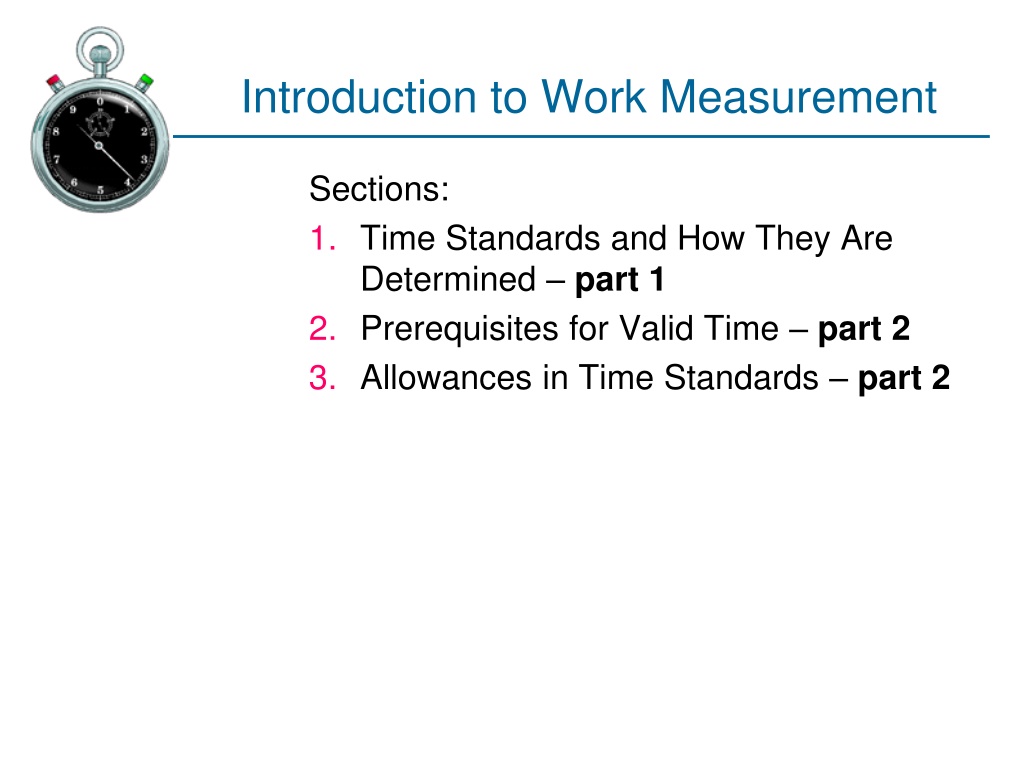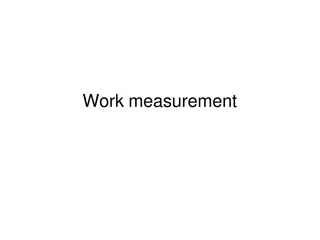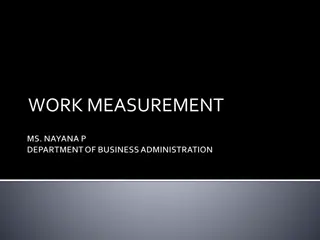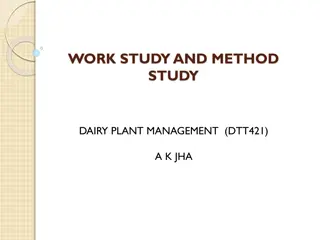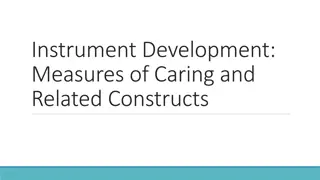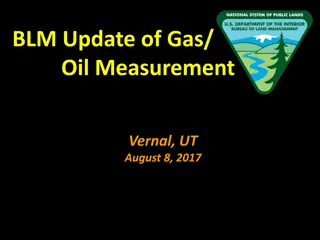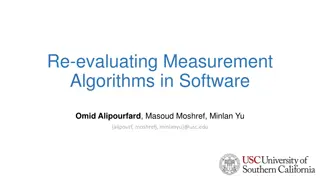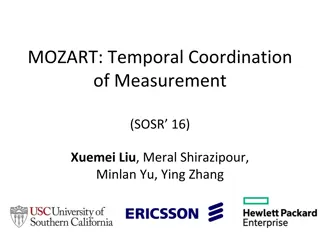Establishing Time Standards for Work Measurement
This article delves into the prerequisites essential for determining valid time standards in work measurement. It emphasizes factors like the average worker's representation, standard performance, and key benchmarks for consistent task execution. Understanding these prerequisites is crucial for setting accurate time standards in various work environments.
Download Presentation

Please find below an Image/Link to download the presentation.
The content on the website is provided AS IS for your information and personal use only. It may not be sold, licensed, or shared on other websites without obtaining consent from the author.If you encounter any issues during the download, it is possible that the publisher has removed the file from their server.
You are allowed to download the files provided on this website for personal or commercial use, subject to the condition that they are used lawfully. All files are the property of their respective owners.
The content on the website is provided AS IS for your information and personal use only. It may not be sold, licensed, or shared on other websites without obtaining consent from the author.
E N D
Presentation Transcript
Introduction to Work Measurement Sections: 1. Time Standards and How They Are Determined part 1 2. Prerequisites for Valid Time part 2 3. Allowances in Time Standards part 2
Introduction to Work Measurement 2. Prerequisites for Valid Time
Prerequisites for Valid Time In order to establish ????for task, following factors must be standardized: 1. Task is performed by average worker 2. Worker s pace represents standard performance 3. Worker uses standard method 4. Task is performed on standard work unit that is defined a) before (input) & b) after processing (output) These definitions must be fully documented for future reference
2.1 Average Worker & Standard Performance Average Worker: person man/woman representative of those who perform tasks similar to the task being measured assumed to have, learned task practiced task and proficient at it performed task consistently throughout shift
2.1 Average Worker & Standard Performance Standard Performance: pace of working: can be maintained by average worker throughout entire work shift, without harmful effects on worker s health or physical well-being worker can achieve this pace day after day normal pace of average worker for given task
2.1 Average Worker & Standard Performance Cont. Standard Performance: work shift: usu. considered: 8-hour workday worker: allowed periodic rest breaks, may experience other interruptions example of benchmarks for standard performance: walking @ 3 ??/ ? (4.82 ??/ ?) on level flat ground
2.1 Average Worker & Standard Performance Worker performance: varies among individual workers variations occur due to, age sex size/physical strength physical conditioning skill/aptitude for task experience/training motivation
2.1 Average Worker & Standard Performance Cont. worker performance: For large numbers of workers, studies show: worker performance: normally distributed ratio of highest performing : lowest performing worker = 2.3 1 Worker performance: usu. indicated by hourly or daily production rate for a representative manual task hourly
2.1 Average Worker & Standard Performance
2.1 Average Worker & Standard Performance Cont. worker performance: Companies: want most workers to be able to achieve standard performance fairly easily define standard to be performance < avg. typical multiplier = 1.30 i.e. average worker should be able to work at pace = 130% of defined standard pace* multiplier
2.1 Average Worker & Standard Performance
2.1 Average Worker & Standard Performance Cont. worker performance: Standard Performance Standard Performance (indust. practice defn): pace of working, standard time for task = 130% of mean time that can be maintained, throughout an entire work shift by average worker without harmful effects on worker s health or physical well-being
2.2 Standard Method Standard Method: procedure that has been determined to be optimum method for processing a work unit safest, quickest, most productive, and least stressful procedure for worker constrained by practical conditions, economic limitations of work environment Should be documented in written statement provide valuable description of task used in resolving disputes regarding: standard method/standard time
2.2 Standard Method Cont. Standard Method: should include following details about how a task is performed: Procedure (actions & motions) used by worker Tools (e.g. fixtures, gauges used) Equipment (machinery and safety) Workplace layout Irregular work elements (tasks not performed every work cycle) Working conditions (e.g. temperature, noise) Setup (e.g. physical tools, setup time)
Introduction to Work Measurement 3. Allowances in Time Standards
Allowances in Time Standards Allowance factor: purpose: compensate for lost time by providing small increment of allowance time in each cycle even with time losses, operator still able to complete fair day s work during hours of shift
Accounting for Lost Time in the Workplace
Types of Allowances Common allowances: 1. Scheduled Break Periods 2. The PFD Allowance Other types of allowances (less common): 3. Contingency Allowances 4. Policy Allowances
Types of Allowances 1. Scheduled Break Periods: planned periods set aside during shift as break time from work examples: lunch breaks (noon 12:30 PM) rest breaks (paid) 1 mid-morning; 1 mid-afternoon usu. last ~15 min. each Here: total paid hrs (8 AM 4:30 PM) = 8*
Types of Allowances 2. The PFD Allowance: ????: used in converting ??into ???? Can be work related or non-work related Personal time: Fatigue allowance Delays P, F, D allowances combined into: ???? Personal time: e.g.: restroom breaks, phone calls, water fountain visits, etc. typical allowance = 5%
Types of Allowances 2. The PFD Allowance: Fatigue/rest allowance: must be taken used to overcome fatigue due to work- related stresses & conditions e.g. work requiring physiologically significant metabolic energy allowance: fatigue in light medium work: 5% fatigue in heavy work: 20% fatigue
Types of Allowances 2. The PFD Allowance: Delays: occur at random times during day usually refer to work-related events delays: responsibility of management examples: machine breakdown waiting for parts or tools waiting for elevator waiting for foreman s instructions harder to find than P or F delays*
Types of Allowances 3. Contingency Allowances: usu. due to some problem with task or production equipment used to perform it should not be > 5%
Types of Allowances 4. Policy Allowances: cover special work situations associated with wage incentive system e.g.: machine allowance: added to machine-paced portion of work cycle in operation of worker-machine system provides opportunity for worker to maintain a high rate of earnings other types of policy allowances: training allowances (teaching other workers) learning allowances (new employees)
Types of Allowances 4. Policy Allowances: ????= ???(1 + ????) + ??(1 + ??) ???: normal time of worker during the worker- controlled portion of the cycle, min ????: PFD allowance ??: machine cycle time, min ??: machine allowance If company policy does not recognize separate machine allowance ??= 0, or set equal to value of ????
Types of Allowances 4. Policy Allowances
Types of Allowances 4. Policy Allowances
